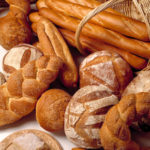To BLAST or not to BLAST?
Bakers and foodservice professionals alike often wonder, what's the difference between Blast Freezing, or Deep Freezing, and more conventional freezing methods? The question we most commonly hear is, "Why should I invest in a Blast Freezer?"
The answer is simple. Quality, space and value!
Product Quality
At a recent demonstration of freezing technology at Johnson & Wales University, freshness was defined as ‘the absence of aging’. Accordingly, the speed at which the product is frozen will determine the freshness of the product, either baked or raw, when it is thawed. The distinction between freezing and blast freezing is in the speed of the freezing process and the subsequent improvement in the quality of the final product. The quicker and more well-balanced the system, the faster the center of the product is frozen resulting in minimal product damage due to the process.
Traditional freezing methods result in the formation of ice crystals that can expand so greatly that they rupture the very cell walls of your product. The speed of the blast freezing process leads to the formation of significantly smaller micro-crystals. The volume of these micro-crystals is only slightly greater than the aqueous substance from which they are formed leaving the cellular structure of your product in near-perfect condition. This prevents the loss of consistency, collapse and sweating that is normally experienced with more traditional freezing methods.

When a successfully blast frozen and properly stored product is brought back to temperature, it will have virtually the same characteristics as that food product would have in its natural state. Frozen berries provide an excellent example of this concept. Upon thawing traditionally frozen berries will bleed and become mushy while their blast frozen counterparts will maintain shape and texture with little to no bleeding.
With regard to final product quality, the four primary aspects of the blast freezing process are:
Low Temperature
A temperature of -18° C* (approx 0° F) must be reached in the heart of product within a certain time limit. This time limit depends on several factors including the type of product, size, thickness, weight and penetration factor. Typically this requires an air temperature around -40° C.
(*NOTE: -18° C for raw dough, -14° C for pre-baked product)
Freezing Speed
This is of vital importance in maintaining the nutritional and physical characteristics of the product. The faster the product can be brought to its target temperature, the smaller the water crystals that form and the smaller the potential for product damage.
"Cold Chain" Continuity
Throughout the marketing cycle and straight up to the time of retail sale, deep-frozen products must be kept at a holding temperature of not less than -18°C.
Proper Packaging
Packaging needs to be done with care to ensure ease-of-use and safeguard the consumer.
Space Efficiency
Typically a traditional freezer will take approximately 6 hours to freeze your product through. A Blast Freezer can have that same product frozen in 30 minutes. This means you would need a freezer with 12 times the capacity of a Blast Freezer to process the same amount of product in a given time. Using a Blast Freezer can help double or triple the capacity of your holding freezer as well, allowing you to fill it with boxes or pallets rather than racks full of product. This efficient use of floor space can increase your production and add to your bottom line.
Investment Value
While blast freezing does require a substantial capital investment it actually proves to be more cost efficient than a traditional freezer system. This is due in large part to the energy efficiency of a Blast Freezing System.
Once your product is frozen it only requires a fraction of the energy it used to initially reach temperature to maintain that temperature. In a traditional system the freezer continues to use the same amount of energy to hold the product as it did when initially freezing. In fact, it is a common mistake to add additional horsepower to a freezer in an attempt to freeze product faster. The result? Still too little power to properly blast freeze your product with the additional negative effects of improper defrosting, equipment cycling and the continued use of much too much energy than is needed to hold the product. An independent energy evaluation will demonstrate that the initial investment can easily be recouped in energy savings over time.
It’s natural to question the investment necessary for a Blast Freezing System. But as a baker, product freshness is the key to your success. An energy efficient Blast Freezing System can all but stop the aging of your products, preserve freshness, increase your output and lower your operating costs. Talk to a trusted equipment supplier today to learn more.

